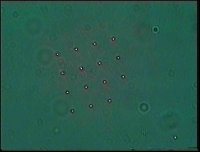Holographic tweezers
Instead of using the output beam straight from the laser, the shape and number of optical traps can be controlled by inserting a spatial light modulator into the beam. Large arrays of traps can be generated (movie below) and moved under computer control.
We demonstrate the advantages of a ferroelectric liquid crystal spatial light modulator for optical tweezers applications. Ferroelectric liquid crystal devices have very short switching times (<100 microseconds) which makes them almost two orders of magnitude faster than conventional nematic devices. This fast switching is shown to enable very rapid reconfiguration of trap geometries, controlled high speed particle movement and tweezers array multiplexing.
We use a commercial liquid crystal microdisplay (CRL Opto Limited) with a 1280 x 1024 reflective pixel array as a pure binary phase modulator. The device is driven from a PC through a Digital Video Interface, which can transfer 24-bit color images at 60 Hz, leading to a maximum binary refresh rate of 1440 Hz. Although the video hardware currently limits the update rate to some tens of Hertz, this is enough to achieve very rapid trap movement of more than 40 microns per second (see below for movie).
For time-multiplexing of optical tweezers the high refresh rates are crucial, as the time that trapped particles stay un-illuminated has to be short compared to the particles’ diffusion time. We demonstrate the first time-multiplexed holograpahic tweezers (again, see below for movie); the example below shows the creation of steerable traps to fill a large static tweezers array.
This work has been published in Optics Express 11 (17), 2053 (2003).
|
4x4 Array of Traps
(477x363—3.26 MB) |
|
|
Fast Rotation of Two Traps Two particles orbiting with increasing speed on a circular trajectory of 10.5-um radius. (480x367—3.89 MB) |
|
|
Time-Multiplexed Trap Array Movie showing five fixed and two movable traps formed by two-to-one multiplex. (717x547—71.1 MB) |
 A static 4 x 4 array of traps getting filled with particles (1 um polystyrene spheres suspended in water).
A static 4 x 4 array of traps getting filled with particles (1 um polystyrene spheres suspended in water).